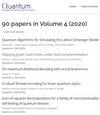纠缠的复杂性
IF 5.1
2区 物理与天体物理
Q1 PHYSICS, MULTIDISCIPLINARY
引用次数: 0
摘要
尼尔森的量子态复杂性方法将准备一个状态所需的最小量子门数量与在单元变换流形上以一定规范计算的测地线长度联系起来。对于一个双分系统,我们研究的是约束复杂性,它对应于作用于单个子系统的门是无代价的规范。我们将这一问题简化为研究施密特系数流形上的大地线,并配以适当的度量。绑定复杂性与分布式计算和量子通信复杂性等其他量密切相关,并在 AdS/CFT 的背景下提出了全息对偶。对于具有黎曼规范的有限维系统,我们发现了约束复杂度与最小雷尼熵之间的精确关系。我们还找到了最常用的非黎曼规范(即所谓的 $F_1$ 规范)的解析结果,并为量子计算和全息中无处不在的相关状态复杂性概念提供了下限。我们认为,我们的结果对于分配给跨子系统作用的生成器的一大类惩罚因子是有效的。我们证明,可以借用我们的结果来研究 $F_1$ 规范情况下单一自旋的通常复杂性(非约束),这在以前的文献中是缺乏的。最后,我们推导出了多部分结合复杂性的边界,以及相关的(连续)回路复杂性,其中回路包含最多 2 美元的局部相互作用。本文章由计算机程序翻译,如有差异,请以英文原文为准。
The Complexity of Being Entangled
Nielsen's approach to quantum state complexity relates the minimal number of quantum gates required to prepare a state to the length of geodesics computed with a certain norm on the manifold of unitary transformations. For a bipartite system, we investigate binding complexity, which corresponds to norms in which gates acting on a single subsystem are free of cost. We reduce the problem to the study of geodesics on the manifold of Schmidt coefficients, equipped with an appropriate metric. Binding complexity is closely related to other quantities such as distributed computing and quantum communication complexity, and has a proposed holographic dual in the context of AdS/CFT. For finite dimensional systems with a Riemannian norm, we find an exact relation between binding complexity and the minimal Rényi entropy. We also find analytic results for the most commonly used non-Riemannian norm (the so-called $F_1$ norm) and provide lower bounds for the associated notion of state complexity ubiquitous in quantum computation and holography. We argue that our results are valid for a large class of penalty factors assigned to generators acting across the subsystems. We demonstrate that our results can be borrowed to study the usual complexity (not-binding) for a single spin for the case of the $F_1$ norm which was previously lacking from the literature. Finally, we derive bounds for multi-partite binding complexities and the related (continuous) circuit complexity where the circuit contains at most $2$-local interactions.
求助全文
通过发布文献求助,成功后即可免费获取论文全文。
去求助
来源期刊

Quantum
Physics and Astronomy-Physics and Astronomy (miscellaneous)
CiteScore
9.20
自引率
10.90%
发文量
241
审稿时长
16 weeks
期刊介绍:
Quantum is an open-access peer-reviewed journal for quantum science and related fields. Quantum is non-profit and community-run: an effort by researchers and for researchers to make science more open and publishing more transparent and efficient.
 求助内容:
求助内容: 应助结果提醒方式:
应助结果提醒方式:


